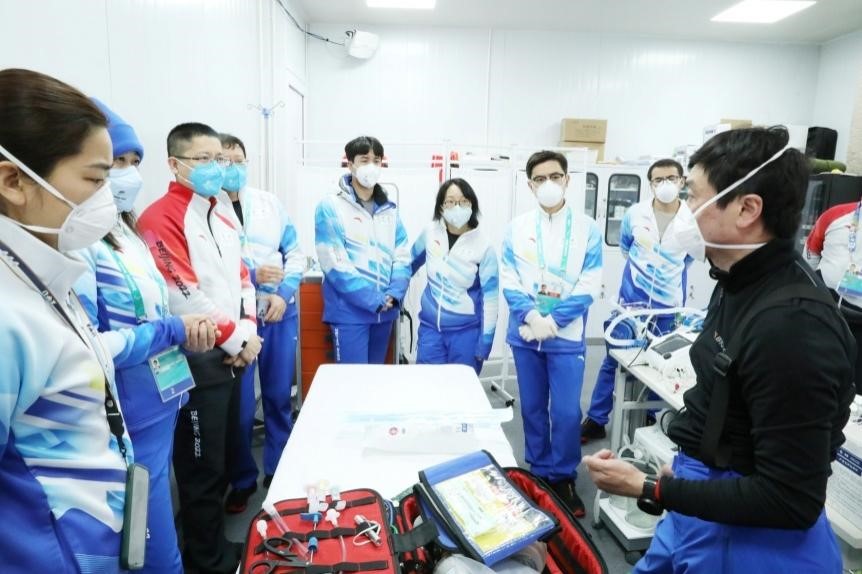After the closing of the Winter Olympics, the NASC (National Alpine Ski Center) was fully converted into the venue for the Paralympic alpine skiing, and the first official training for the Winter Paralympic alpine skiing downhill race started on March 1. Because of the weather became warmer and warmer, the snow on the courses would partially melt in the afternoon and affect the competition; in light of this, the races were overall rescheduled forward by one hour, thus the ski doctors needed to be fully prepared and in position before 7:30 every day.
The morning was intense and busy. I woke up at 5:00 a.m., got on the commuter shuttle bus to NASC at 6:00 a.m., and arrived in position at starting point of Downhill at 7:30 a.m. At 7:50 a.m., the athletes started to examine the course, and at 9:00 a.m., all the course staff were ready. At 10:00 a.m., the forerunners started on course as scheduled.
The Paralympic downhill skiing events fall into three categories: vision impaired, standing and sitting, and male and female athletes compete on the same day. The NASC skiing courses on Xiaohaituo Mountain are extremely challenging, but none of the athletes backed down. Looking at those athletes wearing prosthetic limbs, visually impaired athletes relying on radio guidance from their ski-guiding partners, and paraplegia athletes sitting in mono-skis, each being was so tenacious, so resilient and so resolute, I was instantly moved to tears.
The wind was so strong on March 3 that Gondolas of NASC were out of service for a while. Many athletes fell during the training, which placed the ski medical team under greater pressure. A total of 28 athletes participated in official training of the men’s sitting category, but less than 10 finished the entire course. Several athletes broke their skis, but fortunately no one was seriously injured. I have been skiing for more than a decade, but I’ve never seen skis broken that terribly, which demonstrated how hard those athletes struggled.
The fallings of the athletes prolonged the training time, and it was nearly 15:00 before the official training ended. At this point, I had been standing at my position for nearly 8 hours. When I went down and arrived at the athlete’s medical station, I saw that the meal left for me, which had turned cold, actually had braised pork with preserved vegetables in it, and I was once again moved to tears.
When I returned to our base hotel, the sky was already full of stars. The medical task for the day had been successfully completed, but there was other work to do. Each evening a wrap-up meeting for the day would be held where the ski doctors exchange information about medical service provision of each position, summarize the lessons learned, discuss the workflow optimization, and also make arrangements for the next day. Before the start of the Paralympics, as the only thoracic surgeon in the alpine ski medical team, I had the honor to take on the role of trainer, explaining to the medical station staff the types of common chest trauma on snow tracks, their diagnosis, differential diagnosis and first-aid treatment.
On the stage of the Winter Paralympics, countless athletes with disability fight with grit and tenacity to surpass themselves, writing inspiring chapters of life themed a relentless self-pursuit for better performances. Because of such powerful and touching scenes, the Winter Paralympics is not merely an arena of competitive sports but also an exhilarating cultural symbol. As ski doctors, we stay committed to providing quality medical services for the Winter Paralympics with a high morale and a down-to-earth approach, contributing our share to the endeavor of “two games of equal splendor”!

He Jia was giving medical station staff a training on treating thoracic traumas

Ski doctors were there for athletes when they were competing on a venue of the Winter Paralympics
Written by and picture courtesy of He Jia from the Department of Thoracic Surgery
Translator: Liu Haiyan
Editor: He Jia and Wang Yao
